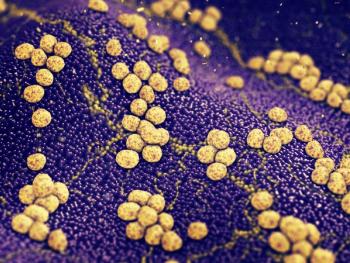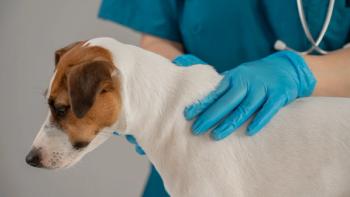
|Articles|October 1, 2011
Differential diagnosis of feline symmetricalalopecia (Proceedings)
Author(s)Edmund J. Rosser, Jr., DVM, DACVD
A symptom of several possible underlying diseases; Not a specific disease entity. A result of excess symmetrical licking with the barbs of the tongue fracturing the hair shafts; rarely is the alopecia spontaneous.
Advertisement
Feline symmetrical alopecia
- Etiology
- A symptom of several possible underlying diseases; Not a specific disease entity. A result of excess symmetrical licking with the “barbs” of the tongue fracturing the hair shafts; Rarely is the alopecia spontaneous.
- Clinical Features
- A non-inflammatory, symmetrical alopecia.
- Most commonly affects the ventral abdomen, inguinal region, perineum, dorsal lumbosacral region, medial and posterior thighs; May also affect the entire ventrum, anterior and medial forelegs.
- May affect “anywhere the cat can lick”.
- Close inspection reveals diffuse thinning of hair rather than “total” alopecia. Owner often unaware of excess grooming behavior.
- May be “secretive” or nocturnal groomers; Problem with “hair balls”.
- Flea Allergy Dermatitis
- Most commonly affects the dorsal lumbo-sacral region, caudo-medial thighs, ventral abdomen, and flanks.
- Warm weather seasonal or non-seasonal pruritus – geographic differences.
- Cutaneous Adverse Food Reactions - “Food Allergy”
- Often affects the ventral abdominal, inguinal regions.
- May also have “miliary lesions” in the pre-aural region, pinnae, neck, periorbital region, and face.
- Non-seasonal pruritus, concurrent GI signs rare!
- Atopic Dermatitis (“Catopy”)
- Most commonly affects the medial thighs, entire ventrum, forelegs.
- May mimic the distribution patterns of Flea Allergy or Food Allergy.
- May be warm weather seasonal, present year round with exacerbations in warm weather, or non-seasonal.
- Parasitic Causes
- Cheyletiellosis (“Walking Dandruff”) - affects primarily the dorsal trunk with excess scaling a major sign. Symmetrical alopecia of the ventral abdomen.
- Demodicosis - Demodex gatoi – short stubby mite. Symmetrical alopecia of the ventral abdomen.
- Otoacariasis (Ectopic Ear Mites) - may mimic the distribution patterns of Flea Allergy, Food Allergy, or Atopy. Usually has concurrent otitis externa.
- Pediculosis (Lice) - Felicola subrostrata. Affects primarily the dorsal trunk. Presence of “nits” on hair shafts.
- Cat Fur Mite - Lynxacarus radovsky. Affects primarily the dorsal trunk. “Salt and pepper” like scale.
- Intestinal Parasite Hypersensitivity - roundworms, hookworms, whipworms, tapeworms, Coccidia. May mimic the distribution patterns of Flea Allergy, Food Allergy, or Atopy.
- Fungal Causes
- Dermatophytosis - most commonly has areas of “patchy” alopecia, scales. History of other pets or humans in the household with skin lesions.
- Malassezia Dermatitis - secondary complication. Brownish discoloration to the skin.
- Miscellaneous Causes
- Hyperthyroidism - excess grooming from “hyperexcitable” behavior.
- Lower Urinary Tract Infections - affects the ventral abdomen.
- Impacted anal glands (Anal sacculitis) - affects the perineal, perianal region.
- Endocrine Causes
- Hyperadrenocorticism - spontaneous symmetrical, truncal alopecia, easily epilated hairs. May have concurrent “skin fragility”.
- Hypothyroidism - ????
- Neoplastic Causes
- Pancreatic Paraneoplastic Alopecia - geriatric cats. Alopecia most commonly on the ventrum and legs. Skin takes on a “shiny” appearance. Easily epilated hairs. Concurrent anorexia, lethargy.
- Psychogenic Causes
- Feline Psychogenic Alopecia - an anxiety neurosis. Often due to a disturbing influence. New puppy or kitten, barking dogs, new baby, recent move, etc. Emotional breeds: Burmese, Siamese, Abyssinian. Sequela to previous pruritic skin disease. Most commonly affects the easiest areas to reach; medial thighs, ventral abdomen, medial forelegs. Darkened hair color in Siamese cats due to melanin pigment increase with cooler skin temperature.
Feline symmetrical alopecia - diagnosis
- Spontaneous vs. Post-traumatic alopecia
- Physical exam - rarely is area completely alopecic, hairs do not easily epilate.
- Trichogram - anagen bulbs with broken distal ends vs. telogen bulbs with fine pointed ends.
- Feline Symmetrical Alopecia: Flea Allergy Dermatitis
- Distribution pattern of lesions - posterior 1/3 of the body.
Advertisement
- Seasonal pruritus.
- Intradermal testing with flea antigen or in-vitro testing for flea.
- Response to intense flea treatment protocol.
- Feline Symmetrical Alopecia: Cutaneous Adverse Food Reactions -“Food Allergy”
- Often affects the ventral abdominal, inguinal regions.
- Non-seasonal pruritus.
- Home cooked, novel protein and carbohydrate elimination diet 8-12 weeks in duration.
- Protein Hydrolysate Diets
- Reduced molecular weight (Daltons) of specific protein in diet.
- Most “allergenic” proteins are in range of 14,000 – 70,000 Daltons.
- Hydrolyzed proteins in the range of 1,000 – 12,000 Daltons.
- Feline Commercial Protein Hydrolysate Diets
- Royal Canin Veterinary Diet: Feline Hypoallergenic HP23 - hydrolyzed soy, chicken fat, rice, beet pulp, fish oil.
- Hill's Prescription Diets: Feline z/d Low Allergen – hydrolyzed chicken and chicken liver, rice, vegetable oil.
- Feline Symmetrical Alopecia: Atopic Dermatitis (“Catopy”)
- Most commonly affects the medial thighs, entire ventrum, and forelegs.
- Seasonal or non-seasonal pruritus.
- Intradermal testing with aeroallergens.
- Aeroallergen specific IgE immunoassay.
- Feline Symmetrical Alopecia: Parasitic Causes
- Most frequently Cheyletiellosis and Demodicosis.
- Skin scrapings, Scotch tape preparations, flea combing, fecal flotation, vacuum technique.
- Response to empirical parasiticidal treatments. Lime sulfur dips vs. selamectin vs. ivermectin vs. fipronil spray.
- Feline Symmetrical Alopecia: Dermatophytosis
- Most commonly have areas of “patchy” alopecia, scales.
- History of other pets or humans in the household with skin lesions.
- Wood's lamp examination, KOH prep, fungal cultures, skin biopsy.
- Feline Symmetrical Alopecia: Hyperthyroidism
- Basal total serum thyroxine (T4).
- Feline Symmetrical Alopecia: Lower Urinary Tract Infections
- Urine culture and susceptibility.
- Feline Symmetrical Alopecia: Impacted anal glands (Anal sacculitis)
- Anal gland extirpation.
- Feline Symmetrical Alopecia: Hyperadrenocorticism
- Spontaneous symmetrical, truncal alopecia, easily epilated hairs.
- May have concurrent “skin fragility”.
- Dexamethasone suppression test - 0.1 mg/kg – baseline, 4 & 8 hours post dexamethasone.
- ACTH stimulation test - measure both cortisol and progesterone.
- Feline Symmetrical Alopecia: Pancreatic Paraneoplastic Alopecia
- Geriatric cats with alopecia most commonly on the ventrum, legs.
- Skin takes on a “shiny” appearance.
- Histopathology - marked follicular atrophy with a mild mononuclear perivascular dermatitis.
- Abdominal ultrasound.
- Serum trypsin-like immonoreativity (TLI).
- Feline Symmetrical Alopecia: Feline Psychogenic Alopecia
- History of change in cat's environment.
- Non-responsive to Prednisolone.
- Elizabethan collar response test.
- Histopathology - normal or very mild superficial perivascular dermatitis.
Feline symmetrical alopecia – treatment
- Flea Allergy Dermatitis
- Environmental treatment - pyrethroid + pyriproxifin; boric acid or sodium polyborate powder.
- Patient treatment - Imidacloprid – q14d + leufenuron – q30d; Fipronil + methoprene – q21d.
- Aqueous hyposensitization with flea salivary antigen.
- Cutaneous Adverse Food Reactions – “Food Allergy”
- Commercial diet avoiding the known offending food source.
- Royal Canin Veterinary Diet: Feline Sensitivity RD30 dry – duck, rice, chicken fat, vegetable oil
- Royal Canin Veterinary Diet: Feline Sensitivity VR canned – venison, rice.
- Hill's Prescriptions Diets: Feline d/d – Canned – lamb and rice.
- IVD – Limited Ingredient Diets - Feline Diets – duck, rabbit, venison, or lamb and green pea – canned or dry.
- Home-cooked Treatment Diets - “novel” protein and carbohydrate source, essential fatty acid dietary supplement, safflower oil, dicalcium phosphate, non-flavored, additive free vitamin and mineral supplement, and taurine for cats.
- Atopic Dermatitis (Catopy)
- Allergen specific immunotherapy (ASIT).
- Prednisolone (not Prednisone) - 1 mg/kg q12h x 7 d, then q24h x 7 d, then q48h at lowest possible dose to control pruritus.
- Graham-Mize CA, Rosser EJ, Hauptman J: Absorption, bioavailability and activity of prednisone and prednisolone in cats. Adv Vet Derm, vol. 5: 152-158.Greater than a 6-fold difference in Cmax of oral prednisolone (Cmax= 1400 ng/ml) vs. oral prednisone (Cmax= 220 ng/ml); Cmax of oral prednisolone after oral prednisone only 122 ng/ml.
- Results indicate both a decreased gastrointestinal absorption of prednisone compared to prednisolone, and possible decreased conversion of prednisone (inactive form) to prednisolone (active form) by the liver in cats.
- Cyclosporine – 5 mg/kg q24h.
- Parasitic Diseases
- Lime sulfur – q7d x 4 weeks - Cheyletiella, Notoedres, Trombicula, Lynxacarus, Demodex gatoi, Felicola subrostrata.
- Selamectin – q14d x 3 treatments - Cheyletiella, Notoedres, Otodectes.
- Fipronil spray – q30d - Cheyletiella, Notoedres, Felicola subrostrata.
- Ivermectin - 200 ug/kg q7d x 4 weeks - Cheyletiella, Notoedres, Otodectes; 200-300 ug/kg q24h - Demodex cati.
- Amitraz – 125 ppm q14d - Cheyletiella, Notoedres, Trombicula, Lynxacarus, Demodex gatoi, Demodex cati, Felicola subrostrata.
- Dermatophytosis: Systemics
- Itraconazole - 5-10 mg/kg q24h with food for 4-6 weeks.
- Terbinafine - 30 mg/kg q24h for 4-6 weeks.
- Lufenuron - 60-100 mg/kg q30d x 2 treatments.
- Dermatophytosis: Topicals
- Lime sulfur - twice weekly for 4-6 weeks.
- Enilconazole topical solution (10%) - twice weekly for 4-6 weeks.
- Miconazole shampoo and leave on rinse 2% (ResiZole) - twice weekly for 4-6 weeks.
- Hyperadrenocorticism
- Unilateral/Bilateral adrenalectomy - Mineralocorticoid maintenance: Fludrocortisone acetate – 0.1-0.3 mg/cat or Desoxycorticosterone pivalate – 2.2 mg/kg SQ once monthly. Glucocorticoid maintenance: Prednisolone – 1.25-2.5 mg/cat/day
- Metyrapone – 65 mg/kg q12h.
- Pancreatic Paraneoplastic Alopecia
- Screen for evidence of metastasis.
- Radiographs and ultrasound - liver, diaphragm, lungs.
- Partial pancreatectomy.
- Feline Psychogenic Alopecia
- Correct or remove disturbing influence.
- Mood altering drugs
- Clomipramine – 1.25-2.5 mg/cat/d.
- Amitriptyline – 5 mg/cat q12h.
- Hydroxyzine – 10 mg/cat q12h.
- Paroxetine HCl – 2.5 mg/cat q24h.
Newsletter
From exam room tips to practice management insights, get trusted veterinary news delivered straight to your inbox—subscribe to dvm360.
Advertisement
Advertisement
Advertisement




